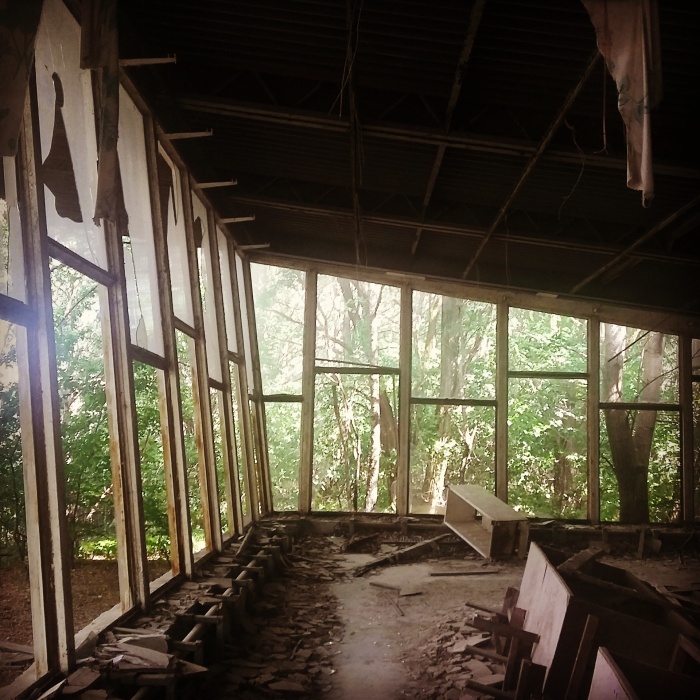
Budynek w Prypeci, 2016. Fotografia: Anna Balazs.
We have always been at war with Eurasia. The history of Eastern Europe is burdened with a series of cataclysmic ruptures and traumatic erasures that continuously reorient narratives of the past and imaginings of the future. The Orwellian dystopia of absolute war turned out to be just as relevant for the reality of the 20th century as his anticipations about the nature of totalitarian regimes: the self-construction of changing ideological systems was based on fluctuating images of the enemy as an ever-present Other. One of the most defining consequences of this historical volatility was the repeated rewriting of spatial textures: cataclysmic events forced communities of various scales to abandon previous localities and ways of living and search for new ones more suitable under the changed circumstances. The present essay explores architectures of trauma in Soviet and independent Ukraine, by showing how the resurfacing trope of war has shaped urban space in its very materiality as well as in symbolic interpretations. War has a regrettable topicality in contemporary Ukrainian reality: the annexation of Crimea by the Russian Federation in 2014 and the ongoing fighting in the Donbas region positioned the country at the center of a major geopolitical conflict, leading to radical transformations in the local geographical, political, and cultural configurations.
Pripyat
Looking back over the last one hundred years of Ukraine, it seems that the experience of war has a continuous influence on the collective imagination even in the transient periods of peacetime. The most elementary realization of this comes from the Chernobyl nuclear disaster: in commemorations of the catastrophe, survivors, and witnesses often interpret the 1986 events as a specific type of war experience. Their reaction corresponds to the general atmosphere of the period, infiltrated by the Cold War discourse, and the still not-so-distant trauma of the Second World War. In a world where Soviet cinemas almost exclusively showed war movies, and the generations who lived through the Great Patriotic War were still in their active years, the immediate association feels fairly appropriate. The state of emergency, confusion, and panic following the nuclear explosion was complemented by the terrifying experience that the new enemy was invisible: the work of radiation was difficult to comprehend for the everyday person, and the emerging uncertainty felt more disheartening than the old and familiar types of hardship. “Chernobyl is like the war of all wars. There's nowhere to hide. Not underground, not underwater, not in the air.”1
The invisible warfare of nuclear catastrophe manifested itself in remarkable visual traces, irreversibly transforming natural and urban landscapes in the Polissya region. Contemplating the concrete sarcophagus covering Reactor Number 4 (known by its official name as the Shelter Object), Thom Davies notes that Chernobyl was preserved by the Soviet state in the same way as Lenin: the great promises of a bright Soviet future are both lying in their graves mummified, preserved for eternity, and in different eerie ways, somewhat still alive.2 The haunting of an incompletely realized and violently crushed utopian future animates every space around the Exclusion Zone: walking on the cracked concrete pavements of Pripyat, the former Atomic City and current capital of East European disaster tourism, the visitor is astonished by the almost transcendent aura of the place. With the slowly decomposing concrete structures hidden in rampant vegetation, Pripyat feels more like the ruins of an ancient civilization than an abandoned industrial city. The elaborate modernist design of the public buildings remains perceptible even through the decay, suggesting the uncanny idea that the city was purposefully planned as a grandiose monument of the Soviet utopia. The reality lies not so far from this: since nuclear power was one of the ultimate symbols of Soviet scientific progress, atomograds like Pripyat were distinguished places providing high quality architecture and urban services compared to the general standards of the period. With the spectacular failure of the nuclear project and the subsequent fall of the whole empire, Pripyat became a major symbol of “all the lost futures that the twentieth century taught us to anticipate.” 3
Ikona w cerkwi w Sławutyczu przedstawiająca Czarnobylskiego Zbawiciela. Fotografia: Anna Balazs, 2016.
Ikona znajdująca się w Muzeum Czarnobyla w Sławutyczu. Wraz z obrazem przedstawiającym elektrownię atomową tworzy instalację przypominającą ołtarz. Fotografia: Anna Balazs, 2016.
Mural znajdujący się na ścianie cerkwi w Sławutyczu. Przedstawia członków Jednostki Ewakuacyjnej. Fotografia: Jordan Skinner, 2016. Dzięki uprzejmości artysty.
Slavutych
Besides the world-famous ghost city, the Chernobyl disaster produced a lesser known urban monument of the discarded socialist utopia. The city of Slavutych was built 45 kilometers from Pripyat to house the evacuated residents of the former atomograd. Due to the urgency of the construction, the government employed a specific strategy in the building process: they invited architect collectives from eight Soviet republics, each of them to design one district of the new town. The Russian, Ukrainian, Baltic and Caucasian planners, all recognized architects of their age, used the most advanced technology and stylistic elements of their home countries, finishing the city in a record speed of a year and a half. This innovative construction method constitutes Slavutych as an open-air museum of late Soviet architecture: each of the districts, named after the capital of the respective builder's republic, represent the state-of-the-art architecture of the period – socialist in content, national in form.
The comprehensive collection of Soviet architectural heritage is unintentional and results from a deeply practical imperative – the planners had been mostly unaware at the time of the construction that the Soviet Union would collapse in three years, providing Slavutych with new significance as the “last socialist city.” While previous periods of Soviet urban planning produced plenty of examples to observe the relation of ideology and space, Slavutych presents a singular opportunity to imagine what would have become the new direction of socialist city building. This architectural new wave is defined by an act of repentance: many of the features of the new town suggest an approach of learning from the past mistakes, largely motivated by the assumption that the Chernobyl catastrophe irreversibly crossed a psychological limit among the citizens. Compared to Pripyat, Slavutych represents an upgraded, more human-faced version of Soviet urban planning: standing as a pioneer of later ecologically sustainable urban projects, the city has no public transport, as all of its parts lie at a maximum twenty-minute walking distance from each other. The public space is completely free from the propaganda messages that had been a fundamental constituent of every socialist city: there are no monuments of Lenin nor other communist heroes, only statues depicting elements of domestic life. Also for the first time in the history of socialist cities, there are private cottages among the housing stock, admittedly built for the workers of the Chernobyl plant as a form of compensation to support their recovery from the traumatic experiences. This thorough revision of former planning principles indicates an underlying sense of a more general shock: Chernobyl presented a paradigm shift in which previously taken for granted worldviews had been shaken. In the orthodox church of Slavutych, there is an icon depicting Jesus in a circle of children suffering from radiation-induced diseases, with the blown-up reactor in the background. The advent of the Chernobyl Savior marks the beginning of a new age, when the cold rationality of Soviet modernism was questioned even by the most reasonable nuclear physicists.

Budynek w dzielnicy Baku w Sławutyczu ozdobiony tradycyjnymi azerskimi motywami na fasadzie. Fotografia: Anna Balazs, 2016.

Spalony budynek administracji miejskiej Mariupola. Fotografia: Anna Balazs, 2015.
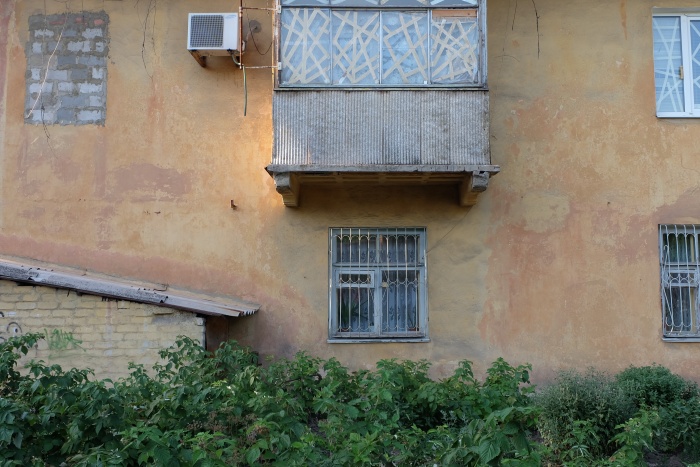
Budynek mieszkalny w Mariupolu. Okna zabezpieczone zostały przed pękaniem taśmą klejącą na wypadek potencjalnego ostrzału. Fotografia: Anna Balazs, 2015.
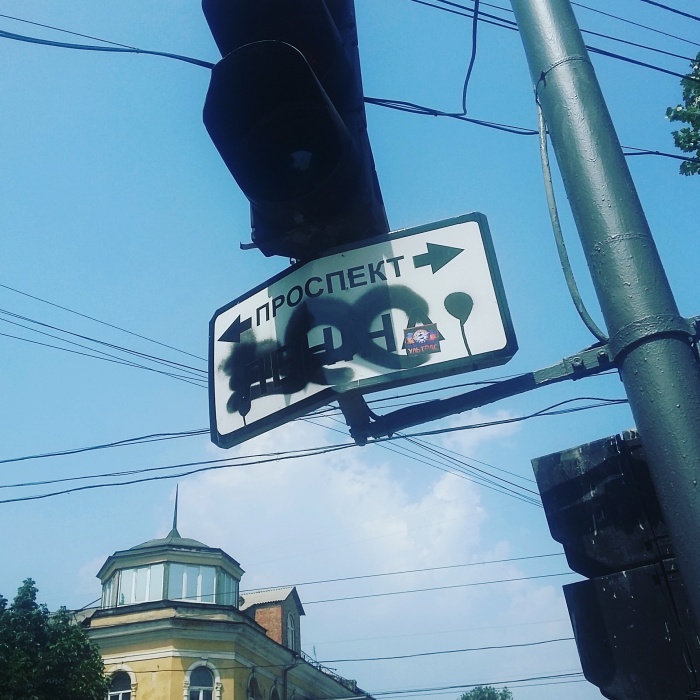
Prospekt Lenina - zamalowany znak z nazwą ulicy w Mariupolu. Została przemianowana z alei Lenina na Miru (Pokoju) na początku 2016 roku jako część działań dekomunizacyjnych na Ukrainie. Fotografia: Anna Balazs, 2016.
Mariupol
While the Chernobyl catastrophe occurred in the last years of the decaying Soviet empire, eventually accelerating its imminent demise, the Donbas war happened in a period of intense social upheaval: when Russian-backed separatist groups started to formulate self-proclaimed republics in the country, Ukraine had already been shaken by the Maidan revolution. The two intricately related events culminated in a historical moment of collective self-reflection, stimulating a nationwide social movement built up from a variety of civil contribution with different scales and political agendas. The changes affected every corner of Ukraine, but the most significant transformations are happening on the Eastern territories near the frontline. The recent history of Mariupol, a middle-size industrial city on the coast of the Azov Sea demonstrates, in a dramatic manner, how erratic moments of political crisis can rewrite previous materialities and social practices. Before its temporary occupation by the separatist militia in the spring of 2014, Mariupol was one of the forgotten places in the East Ukrainian industrial region where economic flows and intellectual movements of the post-socialist age did not come into force to the same extent as in more central localities of the former Eastern Bloc. The majority of urban structure was built in the Soviet times and left mostly untouched in the decades following the collapse of socialism – the tank monuments in the parks, the mosaics on the walls of public buildings, and the still-operating steel factories created an impression of time travel for the visitor who came from other parts of the world, or even Ukraine. The outbreak of the Donbas war radically disrupted this status quo by repositioning the city as a major target of humanitarian intervention and also of Ukrainian cultural activism. The process is best symbolized by the local Dom Sovietov, the administrative building that was burnt down during the fighting and stood in the middle of the city as a constant reminder: what to do with the Soviet urban heritage almost thirty years after the end of socialism, reconstruct it in an unaltered form, or use the opportunity created by the destruction to reflect on the challenges of the present time? The developments of the past few years show that Mariupol has chosen the path of innovation: since 2014, a number of new initiatives have been started by local activists, transforming the physical space of the city and offering new visions for the future. The appearance of hipster cafés, co-working offices, and urban walking tour groups represents global trends of urban development, but the absolute novelty of similar phenomena in the local context constitutes Mariupol as a unique laboratory to observe a “second wave” post-socialist transformation. If Chernobyl represented the final stab for the agonizing Soviet Union, the Donbas war can be interpreted as a symbolic moment to deal with the open ends of socialist legacy, exploiting the potential of turbulent times to approach difficult issues with a fresh perspective.
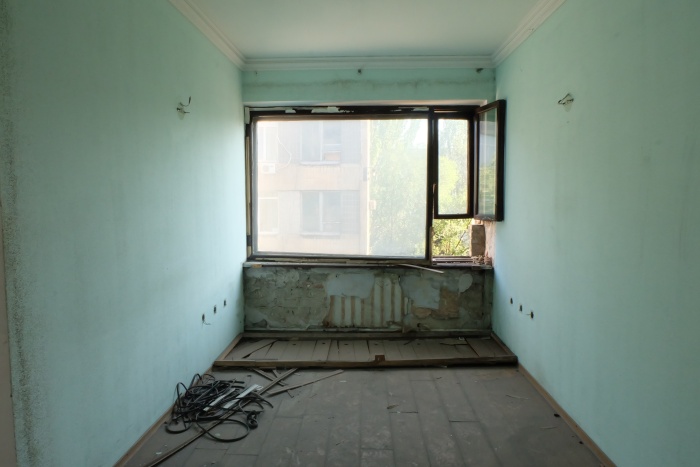
Wnętrze spalonego budynku administracji miejskiej w Mariupolu. Został zniszczony w 2014 roku w trakcie trwającej 2 miesiące okupacji miasta przez separatystów mających rosyjskie wsparcie. Od tego czasu został odbudowany. Fotografia: Anna Balazs, 2015.
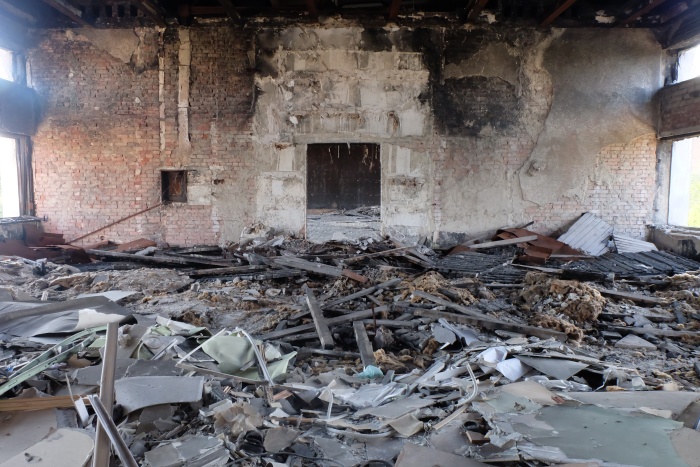
Wnętrze spalonego budynku administracji miejskiej w Mariupolu. Został zniszczony w 2014 roku w trakcie trwającej 2 miesiące okupacji miasta przez separatystów mających rosyjskie wsparcie. Od tego czasu został odbudowany. Fotografia: Anna Balazs, 2015.
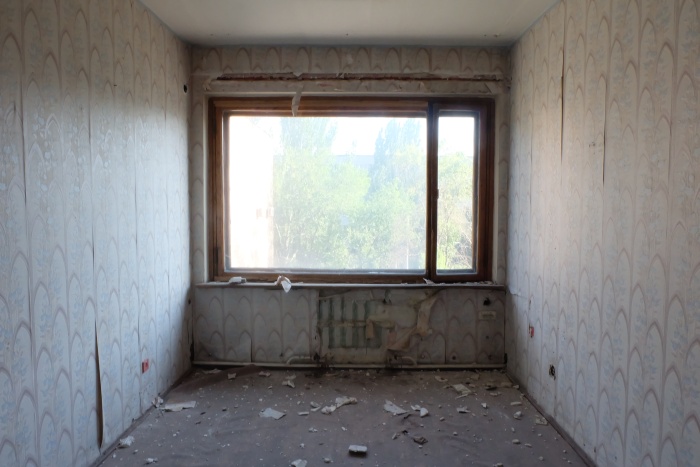
Wnętrze spalonego budynku administracji miejskiej w Mariupolu. Został zniszczony w 2014 roku w trakcie trwającej 2 miesiące okupacji miasta przez separatystów mających rosyjskie wsparcie. Od tego czasu został odbudowany. Fotografia: Anna Balazs, 2015.

Wnętrze spalonego budynku administracji miejskiej w Mariupolu. Został zniszczony w 2014 roku w trakcie trwającej 2 miesiące okupacji miasta przez separatystów mających rosyjskie wsparcie. Od tego czasu został odbudowany. Fotografia: Anna Balazs, 2015.
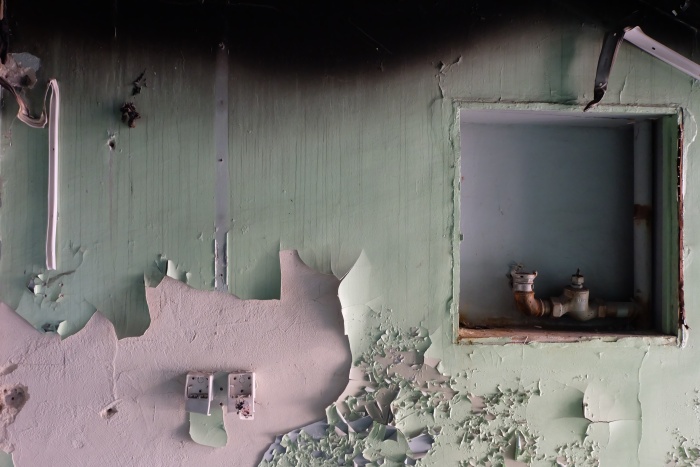
Wnętrze spalonego budynku administracji miejskiej w Mariupolu. Został zniszczony w 2014 roku w trakcie trwającej 2 miesiące okupacji miasta przez separatystów mających rosyjskie wsparcie. Od tego czasu został odbudowany. Fotografia: Anna Balazs, 2015.
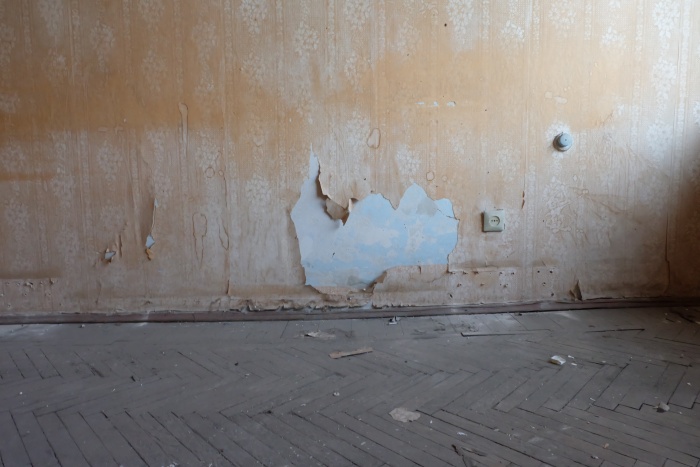
Wnętrze spalonego budynku administracji miejskiej w Mariupolu. Został zniszczony w 2014 roku w trakcie trwającej 2 miesiące okupacji miasta przez separatystów mających rosyjskie wsparcie. Od tego czasu został odbudowany. Fotografia: Anna Balazs, 2015.
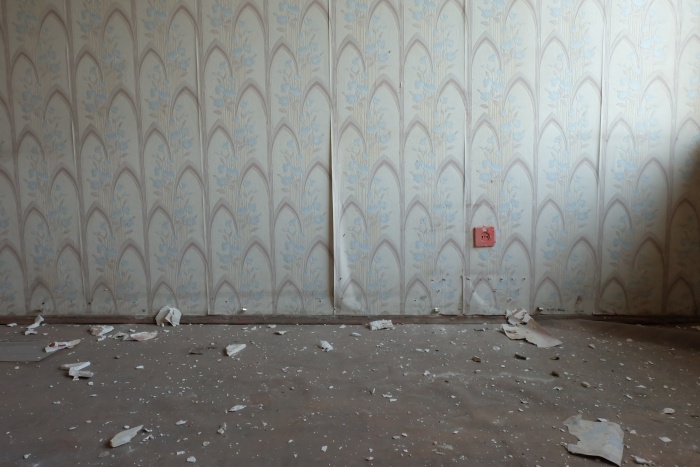
Wnętrze spalonego budynku administracji miejskiej w Mariupolu. Został zniszczony w 2014 roku w trakcie trwającej 2 miesiące okupacji miasta przez separatystów mających rosyjskie wsparcie. Od tego czasu został odbudowany. Fotografia: Anna Balazs, 2015.
BIO
Anna Balázs is a Hungarian anthropologist based in Manchester, UK. She was born in Budapest in 1990, just after the collapse of the socialist system. She studied art and design theory, social science, and urbanism before finding her real calling in social anthropology. Her research focuses on the changing meanings of architecture and urban space in the post-socialist region through case studies of Estonia, Romania, and Ukraine. Currently she is working on her PhD at the University of Manchester, studying urban transformation in the eastern Ukrainian city of Mariupol following the start of the Donbas war.
*Cover photo: The burnt building of Mariupol city administration. Photo: Anna Balazs, 2015
1Svetlana Alexievich, Voices from Chernobyl: The Oral History of a Nuclear Disaster, Dalkey Archive Press, London 2005, [PAGE]
2Thom Davies, “A Visual Geography of Chernobyl: Double Exposure.” International Labor and Working-Class History, no. 84, 2013, 116–39.
3Mark Fisher, “What Is Hauntology?” Film Quarterly 66 (1), 2012, 16–24.



